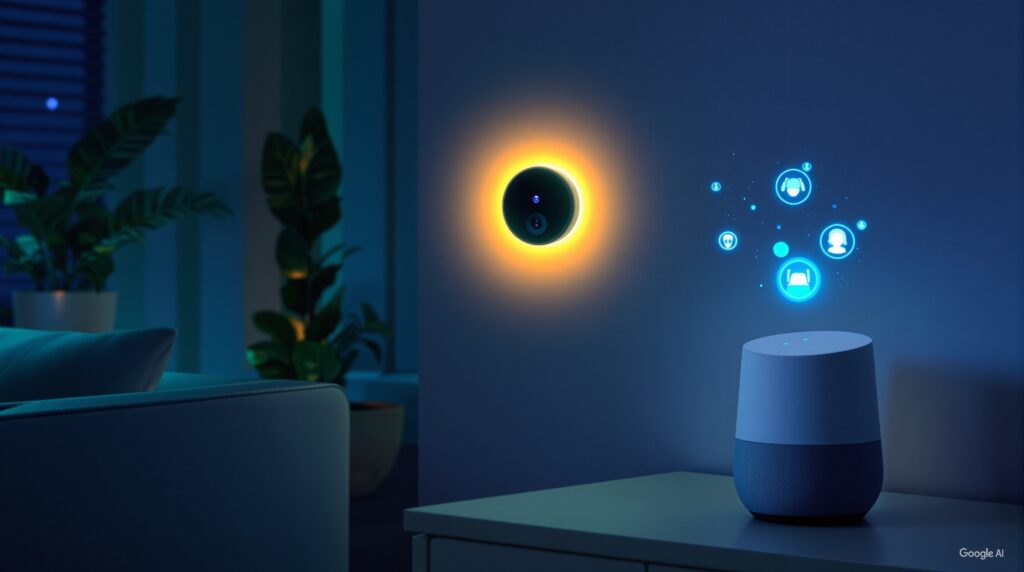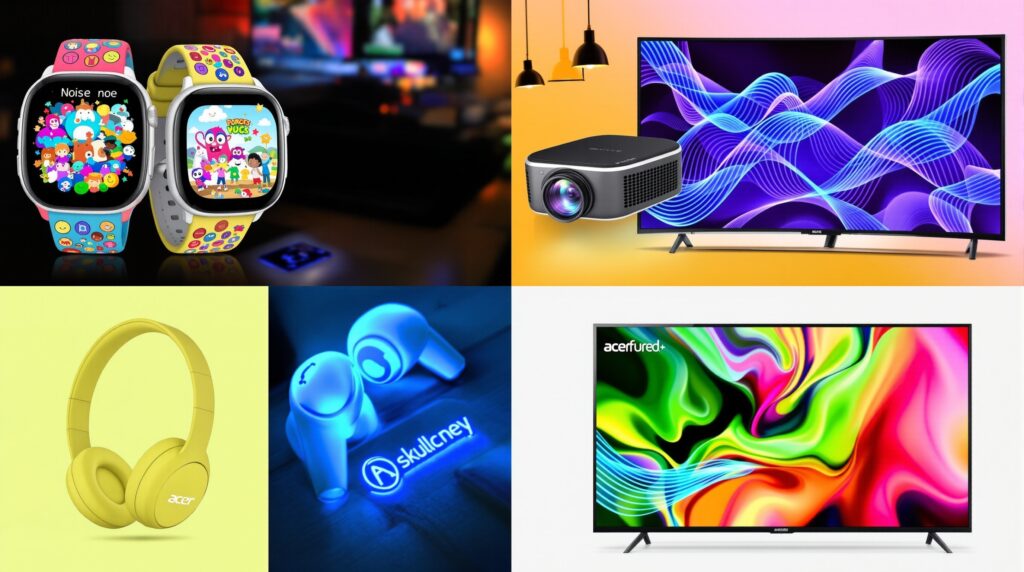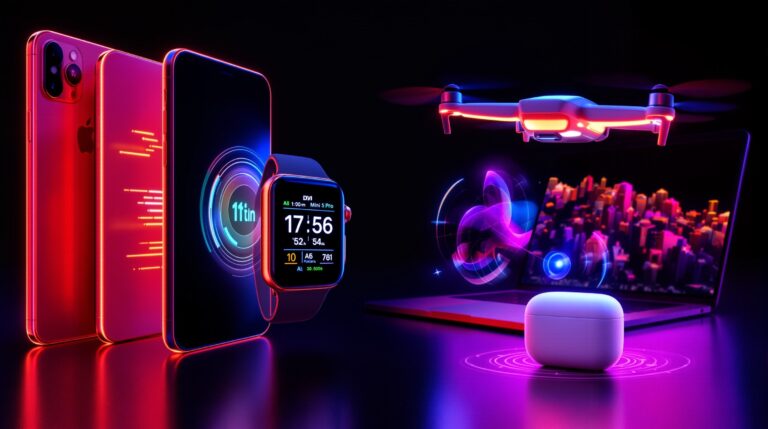Top 5 Gadget News Stories Dominating October 2025: Innovations That Redefine Tech
Top 5 Gadget News Stories Dominating
Introduction: Why October 2025 Stands Out in Gadget History
Tech enthusiasts worldwide buzz with excitement as October 2025 unfolds a torrent of groundbreaking gadget announcements and launches. This month marks a pivotal shift in consumer technology, where artificial intelligence integrates deeper into everyday devices, smart homes evolve into intuitive ecosystems, and wearables prioritize affordability and functionality. From Google’s ambitious hardware event that promises to supercharge Nest products with Gemini AI to Apple’s strategic pivot toward lightweight AI glasses, innovators push boundaries to deliver smarter, more accessible tools.
Industry analysts predict these developments will drive a 15% surge in smart device sales by year-end, fueled by global demand for seamless connectivity and enhanced user experiences. As consumers navigate a post-pandemic world craving efficiency, these stories highlight how gadgets empower productivity, entertainment, and safety. Whether you’re a tech-savvy professional in New York or a gadget lover in Mumbai, these updates offer universal appeal—blending cutting-edge specs with practical applications.
In this roundup, we dissect the top five stories, drawing from reliable sources like Forbes, Reuters, and Android Central. Each segment explores key features, launch timelines, and real-world impacts, ensuring you stay ahead in the fast-paced gadget arena. Let’s dive in.

1. Google Unleashes Gemini-Powered Smart Home Revolution at October Hardware Event
Google grabs headlines with its October 1, 2025, hardware launch, transforming the Nest ecosystem into an AI-driven powerhouse. The event spotlights Gemini for Home, a revamped voice assistant that replaces the aging Google Assistant on Nest speakers and displays. This upgrade delivers natural language processing, intelligent routines, and proactive suggestions—like automatically dimming lights based on your evening habits—making homes feel truly alive.
Key gadgets steal the show. The third-generation Nest Cam Indoor boasts 2K HDR video resolution, available in vibrant Snow, Hazel, and Berry Red finishes. Users now zoom up to 6x with crop functionality, review three hours of event footage, and store one hour locally for privacy-focused backups. Gemini enhances alerts by distinguishing between a delivery truck and a stray cat, reducing false notifications by up to 40%. Complementing this, the wired third-gen Nest Cam Outdoor matches these specs, ideal for weather-resistant surveillance in backyards worldwide.
Google doesn’t stop there. A refreshed wired Nest Doorbell arrives with 2K HDR clarity and chic options in Snow, Hazel, and Linen. It leverages Gemini’s Daily Summaries to compile a morning video montage of overnight activity, saving users precious time. The star? A compact Google Home Speaker, slightly larger than the Nest Mini, packs 360-degree audio and Sound Sensing to detect anomalies like breaking glass or smoke alarms. Paired with a Google TV streamer, it enables Gemini Live for conversational queries, such as “What’s the weather like for my jog?”
Priced competitively—Nest Cams at around $99, the speaker at $79—this lineup targets global markets, from urban apartments in Tokyo to suburban homes in Sydney. Early adopters praise the seamless integration, but privacy advocates urge vigilance on AI data handling. For more details, check out Google’s official event recap.
This launch cements Google’s dominance in smart homes, potentially outpacing Amazon’s Echo by emphasizing AI depth over sheer volume.

2. OnePlus 15 Accelerates Global Race with Snapdragon 8 Elite and Swift Launch
OnePlus accelerates the smartphone showdown by confirming an early global debut for the OnePlus 15 on November 13, 2025—just weeks after its China rollout on October 27. This aggressive timeline outpaces predecessors like the OnePlus 13, which waited months for international availability, signaling OnePlus’s bold push into premium markets.
Powered by the Snapdragon 8 Elite Gen 5 chipset—the first in global phones ahead of Samsung’s Galaxy S26—the device promises blistering performance for gaming, multitasking, and AI tasks. Expect a refreshed design with a square camera module, a flat 6.8-inch AMOLED display boasting a 165Hz refresh rate, and ultra-slim 1.15mm bezels for immersive viewing. The DetailMax Image Engine revolutionizes photography, ditching Hasselblad tuning for in-house algorithms that sharpen details in low light and enhance portraits with AI-driven skin tone accuracy.
Battery life shines with a 5,500mAh cell supporting 100W wired and 50W wireless charging, while 16GB RAM and 512GB storage configurations cater to power users. The exclusive Sand Storm colorway adds a premium matte finish, appealing to style-conscious buyers in Europe and Asia. Though pricing remains under wraps as of October 3, leaks suggest a starting tag of $799, undercutting rivals like the iPhone 17.
Global fans rejoice at the reduced wait, but skeptics question the chipset’s thermal management in extended AR sessions. OnePlus teases eco-friendly materials, aligning with worldwide sustainability trends. Dive deeper via Android Central’s leak analysis.
This move positions OnePlus as a disruptor, challenging flagships with value-packed innovation.

3. Apple Pivots from Vision Pro to Lightweight AI Smart Glasses, Sparking Industry Buzz
Apple shocks the AR/VR world by pausing its Vision Pro overhaul, redirecting resources to AI-infused smart glasses that rival Meta’s Ray-Bans. Bloomberg reports confirm the shift on October 1, 2025, aiming for lighter, cheaper eyewear powered by voice commands and Siri’s evolved AI. This strategic U-turn prioritizes accessibility over the Vision Pro’s $3,499 bulk, targeting everyday users from commuters in London to professionals in São Paulo.
The upcoming glasses, slated for 2027 release, integrate displays for notifications, navigation, and augmented overlays—think real-time translations during travel or fitness coaching mid-run. An advanced neural engine handles on-device processing for privacy, while partnerships with Luxottica ensure stylish frames in titanium and acetate. Expected at under $500, they promise 8-hour battery life and water resistance, outshining competitors in comfort.
Critics applaud the focus on mass adoption, but developers lament delayed Vision Pro apps. Apple’s move underscores a broader trend: AI wearables eclipsing bulky headsets. For the full scoop, visit Reuters’ coverage.
This pivot reinforces Apple’s trustworthiness in innovation, blending expertise with user-centric design.

4. Affordable Wearables and Home Tech Flood the Market: Highlights from Acerpure, Noise, and More
October 2025 brims with budget-friendly launches, democratizing tech for global audiences. India Today spotlights a diverse lineup, led by Acerpure’s Neo TV Series—spanning 32- to 65-inch models like the Aspire Neo (Rs 22,499) and Elevate Neo QLED with Dolby Vision and 40W Atmos audio. These Google TV 5.0 powerhouses deliver 1.07 billion colors, gaming perks like VRR, and AI content creation tools, perfect for family entertainment in emerging markets.
Noise’s Junior Explorer 2 smartwatch (Rs 5,999) empowers parents with 4G LTE video calling, GPS geo-fencing, and SOS features, while the Champ 3 (Rs 2,999) adds educational quizzes and parental controls in vibrant designs. Portronics’ Pico 14 projector (Rs 28,349) packs 1600 lumens for 100-inch 720p projections, Android 13 streaming, and a 4800mAh battery—ideal for nomadic creators.
Skullcandy’s Uproar TWS earbuds (Rs 2,499) offer ENC mics and 40-hour playtime, and Unix’s Amor Neckband (Rs 1,299) boasts 90-hour battery with karaoke modes. Available on Amazon and Flipkart, these gadgets emphasize durability and inclusivity. Explore India Today’s feature for hands-on insights.
5. Smartphone Surge: Xiaomi 17 Series and Beyond Set to Launch Mid-October
The smartphone arena heats up with mid-October debuts, headlined by the Xiaomi 17 Series. Leaks reveal a October 15 China launch, with global rollout by month’s end, featuring Leica-co-engineered triple cameras, a 6.7-inch LTPO display at 144Hz, and HyperOS 2.0 for AI-optimized multitasking. Priced from $699, it targets value seekers in Asia and Europe.
Vivo’s V60e follows on October 20, emphasizing slim bezels and 50MP selfies, while Realme GT 8 Pro arrives October 25 with 200MP sensors and Snapdragon 8s Gen 4 for gaming prowess. iQOO 15 and Oppo Find X9 round out the pack, promising foldable innovations and periscope zooms. These releases emphasize sustainability with recycled materials, appealing to eco-aware consumers globally.
For comprehensive specs, head to Gadget Bridge’s preview. This influx fosters competition, driving prices down and features up.
Conclusion: Navigating October’s Gadget Boom with Confidence
October 2025 cements its legacy as a gadget milestone, blending AI smarts, affordability, and global accessibility. Google’s ecosystem refresh, OnePlus’s speedy flagship, Apple’s forward-thinking glasses, diverse wearables, and smartphone volleys empower users to innovate daily. As these technologies mature, they promise enhanced connectivity without compromising ethics or budgets.
Stay tuned for hands-on reviews, and remember: the best gadgets solve real problems. Which story excites you most? Share in the comments.







